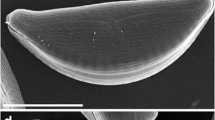Summary
Elongating caulonemal apical cells of the mossPhyscomitrium turbinatum were cultivatedin vitro and observed during successive stages of cell elongation and division. Actively-growing cells which had completed approximately half of their growth in length were examined by electron microscopy. The distribution of many organelles changes progressively from the cell tip to the distal edge of the large basal vacuole, establishing an apical-basal gradient in organization. Whereas the vacuoles become progressively more extensive in more mature parts of the cell, the dictyosomes, chloroplasts and smooth endoplasmic reticulum are more numerous in younger regions. Some mitochondria in the younger regions of the cell contain localized areas of membrane invagination. Attempts were made to clarify the origin and growth of vacuoles, which become increasingly prominent as the apical cell elongates.
Morphological evidence suggests that vacuoles arise in close association with endoplasmic reticulum and dictyosomes as a result of ER dilation and/or cytoplasmic sequestration. The number of vacuolar profiles is highest at the cell tip, decreasing progressively toward the base of the cell, Conversely, the mean area of vacuolar profiles increases progressively toward more basal regions of the cell. These features, along with the increasing number of closely grouped vacuolar profiles along an apical-basal gradient are compatible with the concept of vacuolar growth by coalescence, culminating in their union with the basal vacuole.
Similar content being viewed by others
References
Auderset, G., Greppin, H., 1974: Compartement particulier d'une population mitochondriale au niveau de l'apex caulinaire de l'Epinaud. Planta116, 73–84.
Bagshaw, V., Brown, R., Yeoman, M. M., 1969: Changes in the mitochondrial complex accompanying callus growth. Ann. Bot.33, 35–44.
Buvat, R., 1971: Origin and continuity of cell vacuoles. In: Origin and continuity of cell organelles (Reinert, J., Ursprung, H., eds.), pp. 127–157. Berlin-Heidelberg-New York: Springer.
—,Robert, G., 1979: Vacuole formation in the actively growing root meristem of barley (Hordeum sativum). Amer. J. Bot.66, 1219–1237.
Cresti, M., Pacini, E., Ciampolini, F., Sarfatti, G., 1977: Germination and early tube developmentin vitro ofLycopersicum peruvianum pollen: Ultrastructural features. Planta136, 239–247.
De Maggio, A. E., Stetler, D. A., 1977: Protonemal organization and growth in the mossDawsonia superba: Ultrastructural characteristics. Amer. J. Bot.64, 449–454.
Dyer, A. F., Cran, D. G., 1976: The formation and ultrastructure of rhizoids on protonemata ofDryopteris borreri Newm. Ann. Bot.40, 757–765.
Grove, S. N., Bracker, C. E., Morré, D. J., 1970: An ultrastructural basis for hyphal tip growth inPythium ultimum. Amer. J. Bot.57, 245–266.
James, N. T., 1977: Stereology. In: Analytical and quantitative methods in microscopy (Meek, G. A., Elder, H. Y., eds.), pp. 9–53. Cambridge: Cambridge University Press.
Jensen, L. C. W., 1981: Division, growth, and branch formation in protonema of the mossPhyscomitrium turbinatum: studies of sequential cytological changes in living cells. Protoplasma107, 301–317.
Katsaros, C., Galatis, B., Mitrakos, K., 1983: Fine structural studies on the interphase and dividing apical cells ofSphacelaria tribuloides (Phaeophyta). J. Phycol.19, 16–30.
Medina, F. J., Risueño, M. C., Rodriguez-Garcia, M. I., 1981: Evolution of the cytoplasmic organelles during female meiosis inPisum sativum L. Planta151, 215–225.
Mesquita, J. F., 1969: Electron microscope study of the origin and development of the vacuoles in root-tip cells ofLupinus albus L. J. Ultrastruct. Res.26, 242–250.
Monroe, J. H., 1968: Light- and electron-microscopic observations on spore germination inFunaria hygrometrica. Bot. Gaz.129, 247–258.
Palevitz, B. A., O'Kane, D. J., Kobres, R. E., Raikhel, N. V., 1981: The vacuole system in stomatal cells ofAllium. Vacuole movements and changes in morphology in differentiating cells as revealed by epifluorescence, video and electron microscopy. Protoplasma109, 23–55.
Poux, N., Favard, P., Carasso, N., 1974: Etude en microscopie électronique haute tension de l'appareil vacuolaire dans les cellules méristématiques de racines de concombre. J. Microscopie21, 173–180.
Rosen, W. G., Gawlik, S. R., Dashek, W. V., Siegesmund, K. A., 1964: Fine structure and cytochemistry ofLilium pollen tubes. Amer. J. Bot.51, 61–71.
Schmiedel, G., Schnepf, E., 1980: Polarity and growth of caulonema tip cells of the mossFunaria hygrometrica. Planta147, 405–413.
Sievers, A., 1967: Elektronenmikroskopische Untersuchungen zur geotropischen Reaktion. II. Die polare Organisation des normal wachsenden Rhizoids vonChara foetida. Protoplasma61, 225–253.
Stetler, D. A., de Maggio, A. E., 1972: An ultrastructural study of fern gametophytes during one-to two-dimensional development. Amer. J. Bot.59, 1011–1017.
Uwate, W. J., Lin, J., 1980: Cytological zonation ofPrunus avium L. pollen tubesin vivo. J. Ultrastruct. Res.71, 173–184.
Wada, M., O'Brien, T. P., 1975: Observations on the structure of the protonema ofAdiantum capillus-veneris L. undergoing cell division following white-light irradiation. Planta126, 213–227.
Wilson, K. J., Mahlberg, P. G., 1980: Ultrastructure of developing and mature non-articulated laticifers in the milkweedAsclepias syriaca L. Amer. J. Bot.67, 1160–1170.
Author information
Authors and Affiliations
Rights and permissions
About this article
Cite this article
Jensen, L.C.W., Jensen, C.G. Fine structure of protonemal apical cells of the mossPhyscomitrium turbinatum . Protoplasma 122, 1–10 (1984). https://doi.org/10.1007/BF01279432
Received:
Accepted:
Issue Date:
DOI: https://doi.org/10.1007/BF01279432




